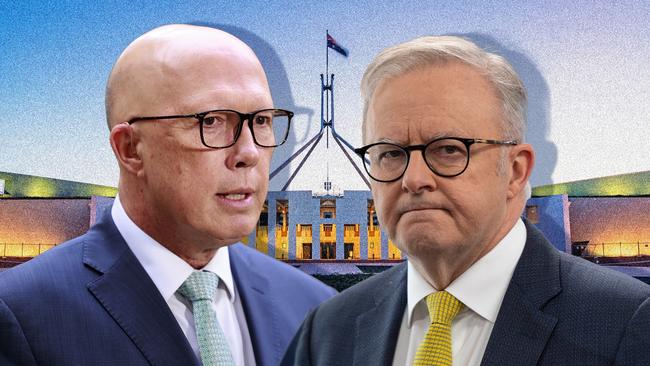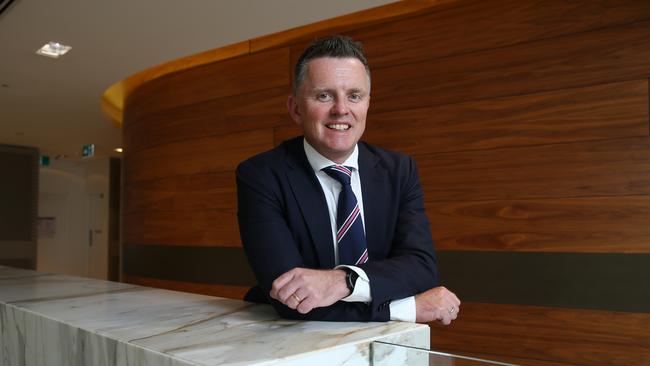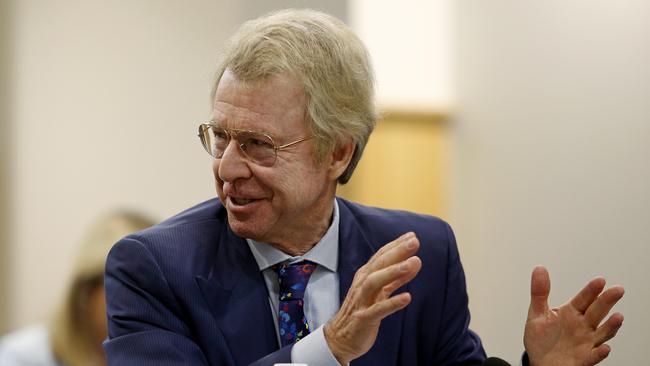Investors to sharpen focus in closely contested federal election
Investors are taking a wait-and-see approach to the federal election on May 3 but a close result or even a minority parliament formed with the help of independents would not go down well.

Business
Don't miss out on the headlines from Business. Followed categories will be added to My News.
Australian financial markets normally take elections in their stride but the prospect of a closely contested battle brings the risk of a “hung parliament” which could hit shares.
Current polling suggests both parties may struggle to get a 76-seat majority, raising the prospect of a hung parliament whereby the Australian Labor Party and Liberal/National Coalition each seek to negotiate with minor parties and independents to form a minority government.
Labor currently has 78 seats but could easily lose three seats and its majority government.
At the same time, the Coalition may struggle to win the 22 seats it needs to form a majority.
While the stockmarket has continued to recover despite the worsening trade war this week as the US announced a 25 per cent tariffs on vehicle imports, Morgan Stanley says a hung parliament would be a significant risk to the Australian economy and stocks in the coming months.
“We see several catalysts or scenarios that could challenge expectations and potentially stunt the green shoots investors are focused on,” Morgan Stanley equity strategist Chris Nicol said.
April is typically the second-strongest month of the year for Australian stocks.
The 20-year average gain for the ASX 200 in April is 1.87 per cent as dividend payments to shareholders tend to be redeployed into the market.
May is typically a weak month with a 20-year average fall of 0.94 per cent as three of the major banks trade ex-dividend and global markets enter the start of the so-called “sell in May” period.
But a minority government, along with a shallow Reserve Bank interest rate cutting path, a worsening trade war, a potential reflation in goods prices and any corporate shift to cost-cutting as a strategy for growth, could “trigger some reversal in animal spirits”, according to Morgan Stanley.

Under Labor, government spending has been a key driver of the economy.
It has generated most of the growth in employment and the economy over the past year.
“This degree of support is unsustainable over the medium term, but looks likely to continue through 2025, supporting activity and jobs but limiting disinflation and RBA easing,” Mr Nicol said. “The election is likely to be an important catalyst and we expect government spending growth to slow in 2026.
“Recent opinion polls indicate there is the potential for a minority government, which would likely see the sharpest deceleration in spending, subject to the make-up of the government.
“A lack of fiscal pulse would take steam out of the economy and a potential air pocket should private sector activity continue to lag.”
AMP head of investment strategy and chief economist Shane Oliver said a minority government would mean that much-needed productivity reforms in Australia would be even less likely, and that a minority Labor government could see it head down a “less business friendly path”.
“To return to decent and sustained real wage gains requires a productivity enhancing reform agenda,” he said. “This election is unlikely to deliver much on this front.”

Labor offers a “continuation of bigger government, a higher tax share to eventually balance the budget, industry policy like ‘Future Made in Australia’ and more regulation.”
This year Labor has promised an extra $37bn in spending over four years on Medicare, urgent-care clinics, roads, the NBN, public schools and the Whyalla steelworks nationalisation. The budget extended electricity rebates and offered tax cuts, albeit they are modest at $5 a week in 2026-27 and $10 a week from July 2027 for an average earner and only give back two years of bracket creep.
“Apart from the tax cuts, the Coalition has committed to matching much of this, but it also promises smaller government, an up to 40,000 cutback in public servants saving $7bn, less regulation, a 12-month halving of fuel excise, an east coast gas reservation to help lower electricity prices and a longer term commitment to nuclear energy,” Dr Oliver said.
“Many of its policy details are still lacking though.”
Both sides of politics are also committed to a big use of off-budget funding, with Labor promising to wipe 20 per cent off student debt and the Coalition looking to use it for its nuclear power stations.
“But this is a sleight of hand as it doesn’t show up in the budget deficit but adds to public debt,” he said.
Meanwhile the Coalition’s nuclear policy is a “huge return to public ownership” and contrary to its small-government philosophy. But while the Coalition is getting closer, neither side is really committing to a reform agenda to put the economy on a stronger path.
“Maybe it’s too much to expect in an election but both sides should at least be levelling with the public in terms of the need for spending restraint and reforms,” Dr Oliver said.
“The relatively modest difference in economic policies between the Coalition and Labor suggests minimal impact on investment markets if there is a change of government.”
“The main risk for investment markets may come if neither side win enough seats to govern, forcing a reliance on minor parties or independents, further delaying productivity reforms and, in the case of a minority Labor government, forcing it down a less business-friendly path.”
If the Coalition were to be elected and implement tighter fiscal policy than Labor, it could allow the Reserve Bank of Australia to loosen monetary policy more aggressively than most expect.
That could lessen the support for consumer discretionary retail stocks like JB Hi-Fi and KFC owner Collins Foods which rose after the federal budget this week.
But it could help the valuation of the broader sharemarket at the margin.
“The Coalition has a track record of lower spending and higher revenue than Labor and we would expect it to tighten fiscal policy,” Capital Economics head of Asia-Pacific Marcel Thieliant said.
“If it sticks to the fiscal rule it adhered to while it was still in power a few years ago, it should now run a balanced budget rather than the small deficit envisaged by Labor over the next couple of years.
“That said, Dutton hasn’t unveiled any concrete fiscal targets so it’s not clear how fast and how far he would rein in Labor’s planned spending binge.”
Dutton intends to do away with “green tape” holding back mining investment and harming businesses by lifting energy prices, but most of the slowdown in iron ore and metallurgical coal exports in recent years reflects a stagnation in global steel production.
“A more friendly stance towards natural gas mining should provide some near-term support, but the long-run prospects for fossil fuel mining remain poor as the world decarbonises,” Mr Thieliant said.
“Meanwhile, Mr Dutton’s plans to use nuclear energy for electricity generation for the first time in Australia’s history would probably raise rather than lower electricity prices.”
Originally published as Investors to sharpen focus in closely contested federal election



